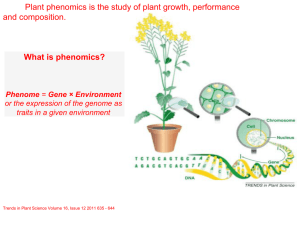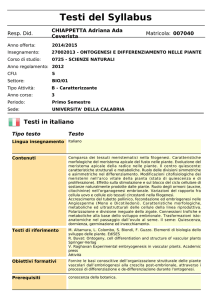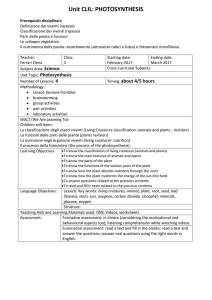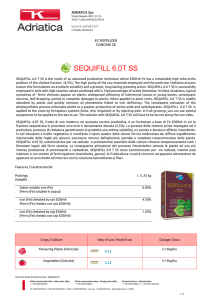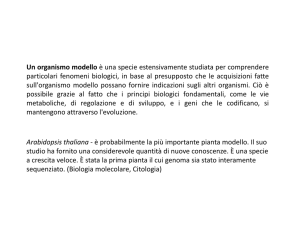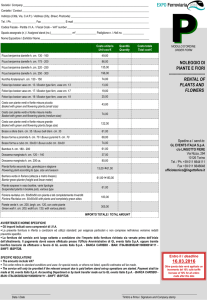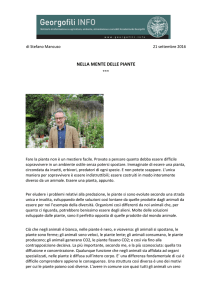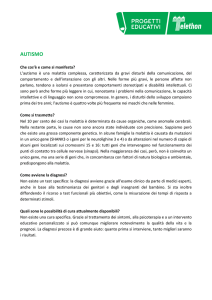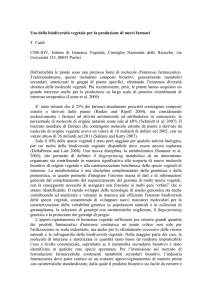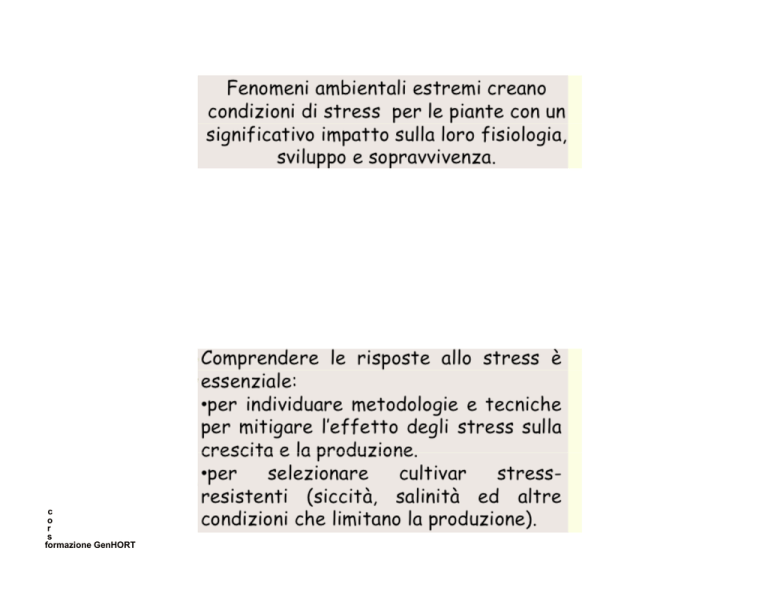
c
o
r
s
formazione GenHORT
What is Plant Stress
• Plant stress is the reaction of plants to
environmental
conditions
that
are
unfavorable to growth, such as lack of
sufficient nutrients, inadequate watering,
flooding, high or low temperature, disease
or insect infestation.
c
o
r
s
formazione GenHORT
Stresses
• External conditions that adversely affect
growth, development, or productivity
• Stresses trigger a wide range of plant
responses:
– altered gene expression
– cellular metabolism
– changes in growth rates and crop yields
c
o
r
s
formazione GenHORT
c
o
r
s
formazione GenHORT
Types of Stress
• Biotic - imposed by other organisms
• Abiotic - arising from an excess or
deficit in the physical or chemical
environment
– Biotic and abiotic stresses can reduce
average plant productivity by 65% to 87%,
depending on the crop, area etc.
c
o
r
s
formazione GenHORT
Biotic Factors
•
•
•
•
•
microorganisms (bacteria and fungal)
virus
parasitic plants (piante parassite)
insects
nematodes
c
o
r
s
formazione GenHORT
Percentuale di aree di terreno degli USA
soggette a stress ambientali
c
o
r
s
formazione GenHORT
Stress
% aree
Siccita’
Freddo
Salinita’
Altri
Nessuno
25,3
16,5
10,8
35,3
12,1
S pec ie
M ais
G rano
S oi a
S orgo
Av e na
O rzo
Patata
B arb ati el a
da zuc c hero
Produz ione
record
Produz ione
m ed ia
Perd ita dovu ta a st ress
ab io tic i
19.3
14.5
7.39
20.1
10.6
11.4
94.1
121.0
4.6
1.88
1.61
2.83
1.72
2.05
28.3
42.6
65.8
82.1
69.3
80.6
75.1
75.4
54.1
50.7
B ray E., 2000
Gli stress abiotici costituiscono il limite
maggiore alla produttività delle colture
c
o
r
s
formazione GenHORT
Nutrient deficiency
•
A lack of one or more essential elements needed by plants for
optimum growth lead to plant stress.
Macroelements
Element
Microelements
Symbol
Element
Symbol
Nitrogen
N
Chlorine
Cl
Phosphorous
P
Iron
Fe
Potassium
K
Boron
B
Manganese
Mn
Calcium
Ca
Zinc
Zn
Magnesium
Mg
Copper
Cu
Molybdenum
Mb
Nickel
Ni
Sulfur
c
o
r
s
formazione GenHORT
S
Other Factors
• Chemical Injury
• Mechanical Injur
• Transplant Shock.
c
o
r
s
formazione GenHORT
c
o
r
s
formazione GenHORT
High temperature Stress
c
o
r
s
formazione GenHORT
Phosphorus deficiency
c
o
r
s
formazione GenHORT
SULFUR DEFICIENCY
c
o
r
s
formazione GenHORT
NITROGEN DEFICIENCY
c
o
r
s
formazione GenHORT
c
o
r
s
formazione GenHORT
Plant Response to Abiotic Stress
• arising from an excess or deficit in the
physical or chemical environment
c
o
r
s
formazione GenHORT
Environmental conditions that can
cause stress
•
•
•
•
•
drought or too much water
high or low temperatures
excessive soil salinity
inadequate mineral in the soil
too much or too little light
c
o
r
s
formazione GenHORT
Congelamento
Freddo
Salinità
STRESS
ABIOTICI
photoinhibition
light
UV damage
Ossidativo
Siccità
Anossia
Contaminazione
suolo e aria
Alte temperature
= Stress osmotico
c
o
r
s
formazione GenHORT
c
o
r
s
formazione GenHORT
Nuovi stress ambientali:
c
o
r
s
formazione GenHORT
•Effetto serra
aumento CO2
•Buco ozono
raggi UVB
•Inquinanti bassa
atmosfera
O3, SO2
Why is there a need for stress
tolerant plants?
• “Drought stress accounts
for more production losses
than
all
other
factors
combined”
• Agricultural plant science has
had two main goals : to
increase yield and quality of
agricultural products and to
improve the protection of
crops to stresses
c
o
r
s
formazione GenHORT
Maize is a typical crop
which scientists are
trying to improve
Why is there a need for stress
tolerant plants?
• As the Earths
population
increases, new
means of improving
crop productivity
must be found to
increase the
resources available.
c
o
r
s
formazione GenHORT
• Intensive irrigation and agriculture
has led to severe problems such as
increased salinity in the soil.
• Global climate change is altering
environmental conditions
c
o
r
s
formazione GenHORT
Stress e produzione
Significato economico dei fattori di stress
abiotico in agricoltura
- Produttività e stabilità delle produzioni
- Potenziale genetico
- Adattamento ambientale
- Conoscenza dei meccanismi d’azione dei fattori
che generano stress e delle reazioni
metaboliche delle piante
c
o
r
s
formazione GenHORT
Come risponde una pianta
a condizioni di stress?
Morte
Anticipo di fioritura/fruttificazione
(sopravvivenza)
Adattamento
Meccanismi protettivi/riparativi
Piante
tolleranti
c
o
r
s
formazione GenHORT
Piante NON
tolleranti
Resistance or sensitivity of plants
to stress depends on:
• the species
• the genotype
• development age
c
o
r
s
formazione GenHORT
Meccanismi adattativi di resistenza:
“ESCAPE”: la pianta previene o sfugge la
condizione di stress (ciclo biologico:
precocità e tardività, dormienza)
Plant avoid the injury of stress by regulating
its life cycle to avoid meeting with stress.
Es. some desert plants
germinate, grow and flower very quickly following seasonal
rains. They thus complete their life cycle during a
period of adequate moisture and form dormant seeds before
the onset of dry season.
c
o
r
s
formazione GenHORT
“AVOIDANCE”: la pianta esclude lo stress: riesce
a mantenere un elevato turgore in condizioni di
deficit idrico (riduzione densità stomatica,
morfologia foliare, sviluppo apparato radicale)
Es.: alfafa survive dry habitats by sending down deep root
systems that penetrate the water table.
Es.: salt-secretion halophytes secrete the salts out from the
leaf thus reduce salt content in the leaf.
c
o
r
s
formazione GenHORT
“TOLERANCE”: la pianta riesce a mantenere le
principali attività metaboliche (accumulo di
prolina, accumulo di ABA, sintesi proteica)
Plants adapt to the stress
by regulating their metabolism
and repair the damage caused by stress.
Es. highly salt tolerant halophytes such as
suaeda salsa survive salty habitat by many
strategies such as high osmotic adjustment ability,
high ion compartmentalization ability and so on.
c
o
r
s
formazione GenHORT
c
o
r
s
formazione GenHORT
c
o
r
s
formazione GenHORT
c
o
r
s
formazione GenHORT
Adaptation / Acclimation
• Adaptation and acclimation both are means of
achieving tolerance to a particular stress.
• Adaptation refers to heritable modifications in
structure or function that increase the fitness of the
organism in the stressful environment.
• Acclimation refers to nonheritable physiological
modifications that occur over the life of an individual.
These modifications are induced by gradual exposure
to the stress. E.g. slow drying increases the drought
resistance of plants.
• The process of acclimation is known as hardening.
c
o
r
s
formazione GenHORT
Stress resistance mechanisms
• Escape
- plant avoid meeting with stress
• Avoidance mechanisms
- prevents exposure to stress
• Tolerance mechanisms
- permit the plant to withstand stress
• Acclimation
- alter their physiology in response stress
c
o
r
s
formazione GenHORT
Damages of stress to the plant
stress
Primary damage
Secondary damage
e.g. water stress in salt stress
Primary directdamage
(injury to the
plasmalemma)
c
o
r
s
formazione GenHORT
Primary indirect
damage
(dysfunction of metabolism)
Damages of stress to the plant
• Bio-membrane
– Change in membrane phase
– Change in membrane constituents
– Change in membrane permeability
c
o
r
s
formazione GenHORT
• Photosynthesis
– Decrease in Photosynthetic rate (Pn)
– Decrease in stomatal aperture
– Decrease in the maximum quantum
efficiency of Photosystem II (Fv/Fm)
c
o
r
s
formazione GenHORT
• Respiration
– Change in respiration path
– Decrease in respiration rate under freezing,
hot and flooding stress
– Increase in respiration rate under wounding
and pathogen stress
– Under chilling and drought stress, the
respiration rate increase first and then
decrease
c
o
r
s
formazione GenHORT
• Changes of phytohormone level
– Decrease in IAA, CTK, GB
– Significant increase in ABA
– Increase of Eth under flooding
c
o
r
s
formazione GenHORT
Cosa si è fatto per migliorare la situazione:
•Modificare l’ambiente (molto poco rispetto stress
biotici): correggendo il pH del suolo, applicando
fertilizzanti (salinità, contaminazioni del suolo, s.
ossidativo), irrigando (siccità),
•Modificare le piante: sviluppo di nuove cultivar
adattate a condizioni ambientali avverse.
c
o
r
s
formazione GenHORT
Sviluppo di cultivar adattate a
condizioni ambientali avverse
•Miglioramento genetico
(incroci, selezione, etc.)
classico
•Nuove
tecnologie
(ingegneria
genetica: isolamento e clonaggio di
geni,
trasformazione
genetica,
rigenerazione piante fertili, etc.)
c
o
r
s
formazione GenHORT
Effetti dell’introduzione di nuove
cultivar resistenti a condizioni di stress
ambientali:
•Aumento della stabilità di produzione nelle attuali
aree coltivate soggette a condizioni ambientali
fluttuanti,
•Possibilità di coltivare in zone attualmente
considerate marginali,
•Riduzione dei costi di produzione (risparmio per
l’irrigazione, uso di acque salmastre, ect.)
c
o
r
s
formazione GenHORT
Fattori che limitano l’intervento genetico:
•Ancora scarsa conoscenza delle basi
biochimiche, fiosiologiche e molecolari della
resistenza,
•scarsa conoscenza delle basi genetiche delle
resistenza (quali geni?, quali funzioni?, quanti
geni?),
•risposta molto complessa, 2000 geni coinvolti.
c
o
r
s
formazione GenHORT
• Classical breeding programs develop new
traits by combining different germplasms in
order to exploit natural or artificially induced
diversity and, subsequently, to select for
desired properties.
• The problem with traditional plant breeding is
that it is time consuming and laborious; it is
difficult to modify single traits; and it relies on
existing genetic variability.
c
o
r
s
formazione GenHORT
How plants respond to
environmental stress
Environmental
stress
Stress
characteristics
Plant
characteristics
Severity
Severity
Organs or
tissue in
question
Duration
Duration
Number of
Number
of
expositiom
exposition
Combination
of stresses
c
o
r
s
formazione GenHORT
Response
Results
Resistance
Survival and
growth
Stage of
development
Susceptibility
Genotype
Death
Changes in gene expression to
stress
• A stress response is initiated when plants
recognizes stress at the cellular level
• Stress recognition activates signal
transduction pathways that transmit
information within the individual cell and
throughout the plant
• Changes in gene expression may modify
growth and development and even influence
reproductive capabilities
c
o
r
s
formazione GenHORT
Regulation of plant stress
responses
•
•
•
•
Abscisic acid (ABA)
Jasmonic acid
Ethylene
Calcium
c
o
r
s
formazione GenHORT
Gene expression results in:
•
•
•
•
•
Increase amounts of specific mRNA
Enhance translation
Stabilize proteins
Altered protein activity
A combination of the above
c
o
r
s
formazione GenHORT
percezione del segnale di stress
Trasmissione/amplificazione
Plant response
osmoliti osmoprottetivi
de novo sintesi
di proteine
bilancio metaboliti
antiossidanti
accumulo ABA
uptake ioni
STRESS
turnover proteico
modificazione parete
antipatogeni
sequestro ioni
c
o
r
s
formazione GenHORT
modificazione membrane
Plants are sessile and must affront
stresses in place
•
Plants cannot avoid stress after germination
•
How plants affront stress has implications in
– Ecology: Stress responses help explain geographic
distribution of species
– Crop science: Stress affects productivity
– Physiology and biochemistry: Stress affects the
metabolism of plants and results in changes in gene
expression
c
o
r
s
formazione GenHORT
Heat-stressed wheat
Stresses are abiotic or biotic
•
•
•
ABIOTIC STRESSES
BIOTIC STRESSES
Environmental, nonbiological
• Temperature (high /
low)
• Water (high / low)
• Salt
• Radiation
• Chemical
Caused by living
organisms
• Fungi
• Bacteria
• Insects
• Herbivores
• Other
plants/competition
Stresses cause responses in
metabolism and development
Injuries occur in susceptible plants,
can lead to impeding flowering,
death
Ephemeral plants avoid stress
– Mexican poppies in US desert SW
– Only flower after wet winter
– Die before summer returns
c
o
r
s
formazione GenHORT
Preferable!
Plants must be stress resistant to survive
•
Avoidance also possible by morphological adaptations
– Deep tap roots in alfalfa allow growth in arid conditions
– Desert CAM plants (a plant that utilizes the Crassulacean
acid metabolism (CAM) as an adaptation for arid conditions)
store H2O in fleshy photosynthetic stems
•
•
Stress resistant plants can tolerate a particular stress
- Resurrection plants (ferns) can tolerate dessication of
protoplasm to <7% H2O can rehydrate dried leaves
Plants may become stress tolerant through
– Adaptation: heritable modifications to increase fitness:
CAM plants’ morphological and physiological
adaptations to low H2O environment
– Acclimation: nonheritable physiological and
biochemical gene expression: cold hardening induced,
by gradual exposure to chilling temps, tolerance in
plants
c
o
r
s
formazione GenHORT
Alfalfa plant
Alfalfa
taproot
Heat stressed
rose leaf
•
•
•
•
•
Growth rate
Temperature
ABIOTIC STRESS: Temperature
Plants exhibit a wide range of T.opt (optimum
temperature) for growth
We know this is because their enzymes have evolved for
optimum activity at a particular T
Environmental conditions frequently oscillate outside ideal
T range
Deserts and high altitudes: hot days, cold nights
Three types of temperature stress affect plant growth
Chilling, freezing, heat
c
o
r
s
formazione GenHORT
T.opt
Growth temperature
Chilling injury
•
Common in plants native to warm habitats
– Peas, beans, maize, Solanaceae
•
Affects
– seedling growth and reproduction
– multiple metabolic pathways and physiological processes
• Reduced respiration, photosynthesis, protein synthesis
• Patterns of protein expression
•
•
•
•
Initial metabolic change: alteration of physical state of cellular
membranes
Temperature changes lipid and thus membrane properties
Chilling sensitive plants have more saturated FAs in membranes: these
congeal at low temperature (like butter!)
Liquid crystalline gel transition occurs abruptly at transition
temperature
c
o
r
s
formazione GenHORT
Livello
pianta
•
•
•
Livello
cellulare
Livello
fisiologico
•
membrane
riduzione della
crescita fogliare
• chiusura degli
stomi
•
potenziale osmotico
•
potenziale idrico
cambiamenti
dell’ apparato
radicale
• diminuzione
della velocità
fotosintetica
•
sintesi proteica
•
sviluppo
riproduttivo
• danno
fotoossidativo
funzionalita’
cloroplasto
•
modificazioni della
parete
•
ciclo cellulare
•
struttura del DNA
Modificazione
dell’espressione
genica
c
o
r
s
formazione GenHORT
Stress
Danno
Risposta
cellulare
Cambiamenti
strutturali
fisiologici
intensità
durata
biochimici
Stress
c
o
r
s
formazione GenHORT
Adattamento
Nuova omeostasi
EVITARE
STRESS
canali ionici
canali permeabilità all’acqua
Osmoliti osmoprotettivi
PROTEZIONE
aggiustamenti strutturali
chaperonine
RIPARO
degradazione proteica
distruzione tossine
PROTEZIONE
CONTRO ALTRI
STRESS
c
o
r
s
formazione GenHORT
antiossidanti
antipatogeni
La risposta della pianta a stress idrico induce
cambiamenti dell’espressione genica
PEG
Adattamento
controllo
c
o
r
s
formazione GenHORT
PEG
Shock
Control cells
shock
PEG acclimated
ABA
Molte delle proteine indotte da shock idrico sono indotte anche da ABA
c
o
r
s
formazione GenHORT
Stress
Percezione del Segnale
Trasduzione del Segnale
Risposta: espressione genica
prodotti genici
c
o
r
s
formazione GenHORT
Proteine funzionali
Regolatori
Proteine del trasporto
Biosintesi osmoliti
Chaperoni molecolari
Proteine LEA
Proteinasi
Enzimi detossificanti
Fattori di trascrizione
Calmoduline
Protein Chinasi/fosfatasi
Fosfolipasi
Tolleranza allo stress
Risposta allo stress
Stress diversi inducono una risposta simile
Strategie simili
•
•
•
•
Percezione del segnale
Trasduzione del segnale
Risposta:espressione genica
Nuova omeostasi cellulare
Stessi meccanismi
molecolari
•
•
•
•
ABA, canali ionici
Geni Lea e Cor
chaperonine
SOD, catalasi, etc
c
o
r
s
formazione GenHORT
Cambi metabolici simili
•
•
•
•
•
Modificazioni delle membrane
Sintesi di ormoni
Sintesi proteica
Sintesi di osmoliti
Variazione di pH
Coinvolgimento di
fattori identici
• Ca2+,chinasi, fosfatasi
• fattori di trascrizione
Stress
Risposta cellulare allo stress
membrana
sensore
Osmosensori
(AtHK1)
Ca2+
MAP kinases
Trasduzione del segnale
Fosforilazione/
defosforilazione
ABA
Fattori di trascrizione
Espressione genica
c
o
r
s
formazione GenHORT
CBF/DREB, MYB bZIP
Funzioni chaperone
(HSP, LEA)
Detossificazione
Osmoprotezione
(proline, betaine)
Messageri secondari
Ca 2+
Risposte biochimiche/
cellulari
Rispota fisiologica
Movimento di acqua e ioni,
(acquaporine trasportatori di
ioni)
Tolleranza allo STRESS?
Fattori
ambientali
Variazioni
[ABA]
Percezione
L’ ABA è un importante
mediatore della risposta
delle piante a stress idrico
Ca++, cAMP?, IP?
kinasi/fosfatasi
Trasmissione
del segnale
Risposte
Fattori di
trascrizione
Cambiamenti
espressione genica
Effetti
Chiusura stomi
Resistenza alla
dessiccazione del seme
c
o
r
s
formazione GenHORT
Inibizione della
germinazione
Mutanti ABA deficient
di pomodoro
Incapaci di accumulare ABA
in risposta a stress idrico
Gli stomi restano aperti
Traspirazione eccessiva
Perdita 80% peso fresco in 4 h
c
o
r
s
formazione GenHORT
Fig. 1. Simplified scheme of the signalling systems responding to mild or severe stressors.
Abbreviations: EEE, excess excitation energy; IP3, inositol-1,4,5-trisphosphate; PA, phosphatidic
acid; PLD, phospholipase D (phospholipid signalling); PtdOH, phosphatidylalcohol; PUFA,
polyunsaturated fatty acids; RLKs, receptor-like kinases; ROS, reactive oxygen species; RWC,
relative water content; WAKs, wall-associated kinases.
c
o
r
s
formazione GenHORT
Espressione del fattore di trascrizione WRKY di orzo
in risposta a disidratazione
0
30
90 180 min
WRKY e’ indotto
in foglie disidratate
L’espressione di WRKY
Non e’ indotta da ABA
WRKY fa parte di un sistema di risposta a stress ABA - indipendente
c
o
r
s
formazione GenHORT
Stress
Calmodulin expression
in potato cells
C 5’ 10’ 30’ 1h 2h
4h
Increase in
Ca++ levels
Cold
Ca++
activated
calmodulin cascade
CaM1
CaM5
28S
18S
Heat
Kinases
phosphatases
CaM1
CaM5
28S
18S
drought
acclimation
shock
CaM1
CaM5
28S
18S
c
o
r
s
formazione GenHORT
Identificazione in grano duro di geni regolatori
della risposta a stress idrico
Approccio sperimentale
Selezione da una libreria arricchita
In messaggi indotti da stress
Approccio in silico
Selezione di sequenze di regolatori
noti in altre specie ( es. CBF)
da banche dati di EST di grano
Studio funzionale di 14 geni selezionati
durante lo sviluppo della pianta in condizione di stress
c
o
r
s
formazione GenHORT
Influenza dello stadio di sviluppo sulla risposta alla siccita’ in grano duro
6H8:
in leaves, in roots
3H9: CBF like, in leaves
TF
TF
TF
c
o
r
s
formazione GenHORT
Problemi del “Breeding tradizionale”:
•Complessità dei geni di tolleranza,
•bassa variabilità genetica della resa in
condizioni di stress,
•mancanza di efficienti tecniche di selezione.
……possibili aiuti delle biotecnologie:
Inserimento di pochi geni in maniera più
mirata e più rapida
c
o
r
s
formazione GenHORT
MA CHE GENI STUDIARE? E DOVE CERCARLI?
•Specie che normalmente si trovano in habitat estremi (craterostigma,
“ice plant”, atriplex): studio dei meccanismi di adattamento messi in
atto in queste specie, IMPORTANTE: meccanismi adattativi
esistono sia in piante tolleranti che non tolleranti
•Studio della risposta in piante non adattate e veder quanto la risposta sia
collegata alla capacità della pianta di superare le condizioni di stress.
Induzione e repressione dei geni
•Uso dell’ingegneria genetica direttamente sui geni isolati da procarioti
ed eucarioti inferiori la cui funzione è nota in questi sistemi nel conferire
tolleranza o adattamento
c
o
r
s
formazione GenHORT
INGEGNERIA GENETICA
•Definire il problema,
•Isolare gene/i,
•Manipolare il gene per una efficiente
espressione nel tessuto/stadio biologico
desiderato,
•Sviluppare un sistema di trasformazione
e rigenerazione di tessuti vegetali,
•Selezionare i genotipi trasformati,
•Valutare l’espressione del gene inserito,
•Valutare l’effetto del gene inserito.
c
o
r
s
formazione GenHORT
Come isolare i nuovi geni?
IERI:
•Metodi biochimici
•Screening differenziale
•Ibridazione sottrattiva
•DDRT-PCR
•Northern analysis
•cDNA-AFLP
OGGI-DOMANI?:
•Sequenziamento su larga scala di EST
•DNA microarray
•“Functional genomics: forward - reverse genetics”
•NGS
c
o
r
s
formazione GenHORT
New tools
Novel strategies
Plant genome sequence (Arabidopsis)
Mutants : stress related phenotype
c
o
r
s
formazione GenHORT
How plants get adapted to
stress?
1.
2.
3.
4.
5.
c
o
r
s
formazione GenHORT
Osmotic adjustment
Stress proteins
Scavenge ROS
Synthesis ABA
Cross-adaptation
1 Osmotic adjustment
①
Water deficit can be induced by many environmental
conditions
•
Drought
•
Salinity
•
Cold temperature
②
Osmotic adjustment is a biochemical mechanism that helps
plants to acclimate
③
Osmotic adjustment is an active process of increasing the
number of solute particles in the plant that resulting in a
reduced osmotic and water potential and enables the plant to
absorb water in drought and saline habitat.
c
o
r
s
formazione GenHORT
c
o
r
s
formazione GenHORT
Osmotic adjustment continuation:
④ Compatible solutes
•
•
•
•
•
c
o
r
s
formazione GenHORT
Highly soluble
Low molecular weight
Do not interfere with cellular metabolism
Neutrally charged at physiological pH
Mainly distributed in the cytosol, not
vacuoles
Most compatible osmolytes are AA, QACS or poly alcohols
c
o
r
s
formazione GenHORT
Osmotic adjustment continuation:
⑤ Some compatible solutes may serve other
protective functions in addition to osmotic
adjustment
•
•
•
c
o
r
s
formazione GenHORT
Minimizing the perturbing impact of ions
Protecting enzymes (pro, glycine betain)
Scavenging ROS (pro, mannitol, sorbitol)
2 Stress proteins
• HSPs(Heat shock proteins)
• CRP(Cold regulated proteins)
• LEAs(late embryogenensis abundant
proteins)
• Osmotin
• Pathogenesis-related proteins
c
o
r
s
formazione GenHORT
3 Scavenging ROS
Reactive oxygen species (ROS) are chemically reactive molecules
containing oxygen
•
Enzymes:
1) SOD(superocide dismutase)
2) CAT (Catalase)
3) POD (Ascorbic acid Peroxidase)
•
Anti-Oxidants:
1)
2)
3)
4)
5)
c
o
r
s
formazione GenHORT
carotene
Vit E
DMSO
Vit C
GSH
4 ABA-stress hormone
•
•
•
•
Keep membrane stability
Promote synthesis of osmolytes
Reduce water loss
Increase water conductivity
c
o
r
s
formazione GenHORT
Cross-adaptation
• Cross-adaptation: exposure of an
organism to a given adverse
environment =>modifies its response to
other adverse factors.
– E.g. exposure of plants to various stresses
such as chilling temperature, heat, drought,
and conferred resistance to other stresses.
c
o
r
s
formazione GenHORT
Causes of cross-adaptation
• ABA is induced under many stresses.
• Stress induces many stress proteins,
and stress protein functions in many
stresses.
• Osmolytes are induced by many
stresses
• Membrane change
• ROS scavenging system is activated
c
o
r
s
formazione GenHORT

